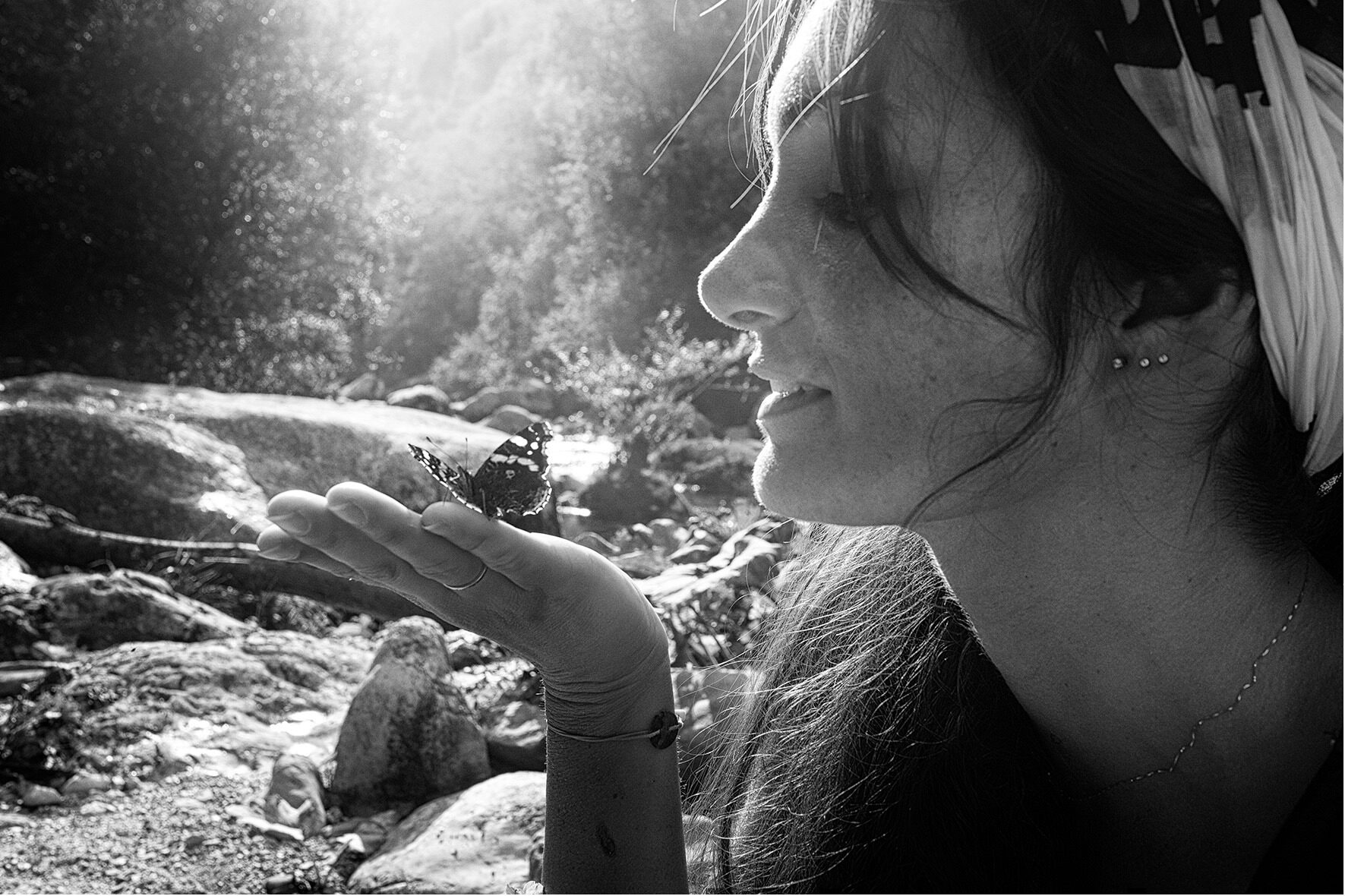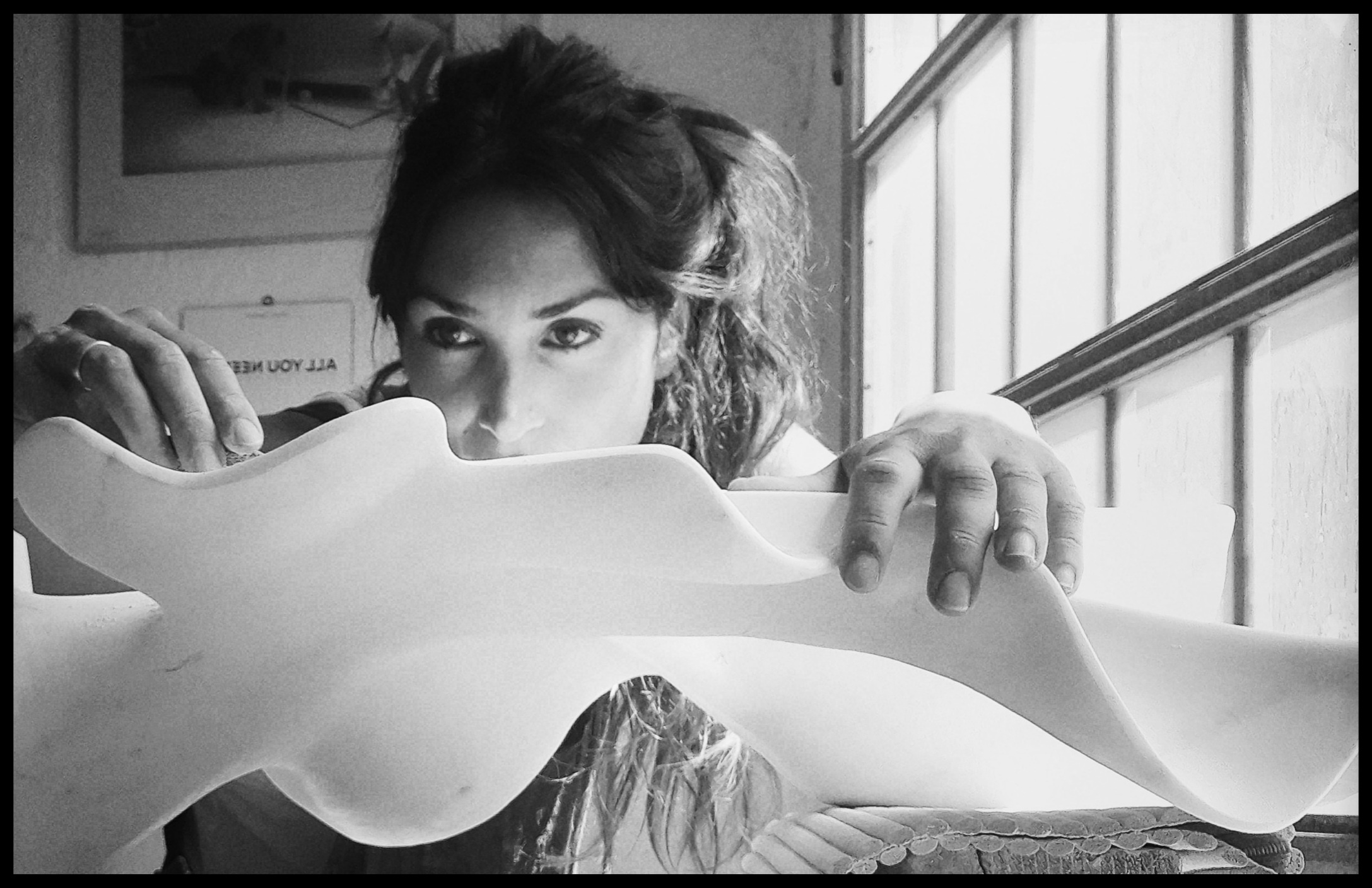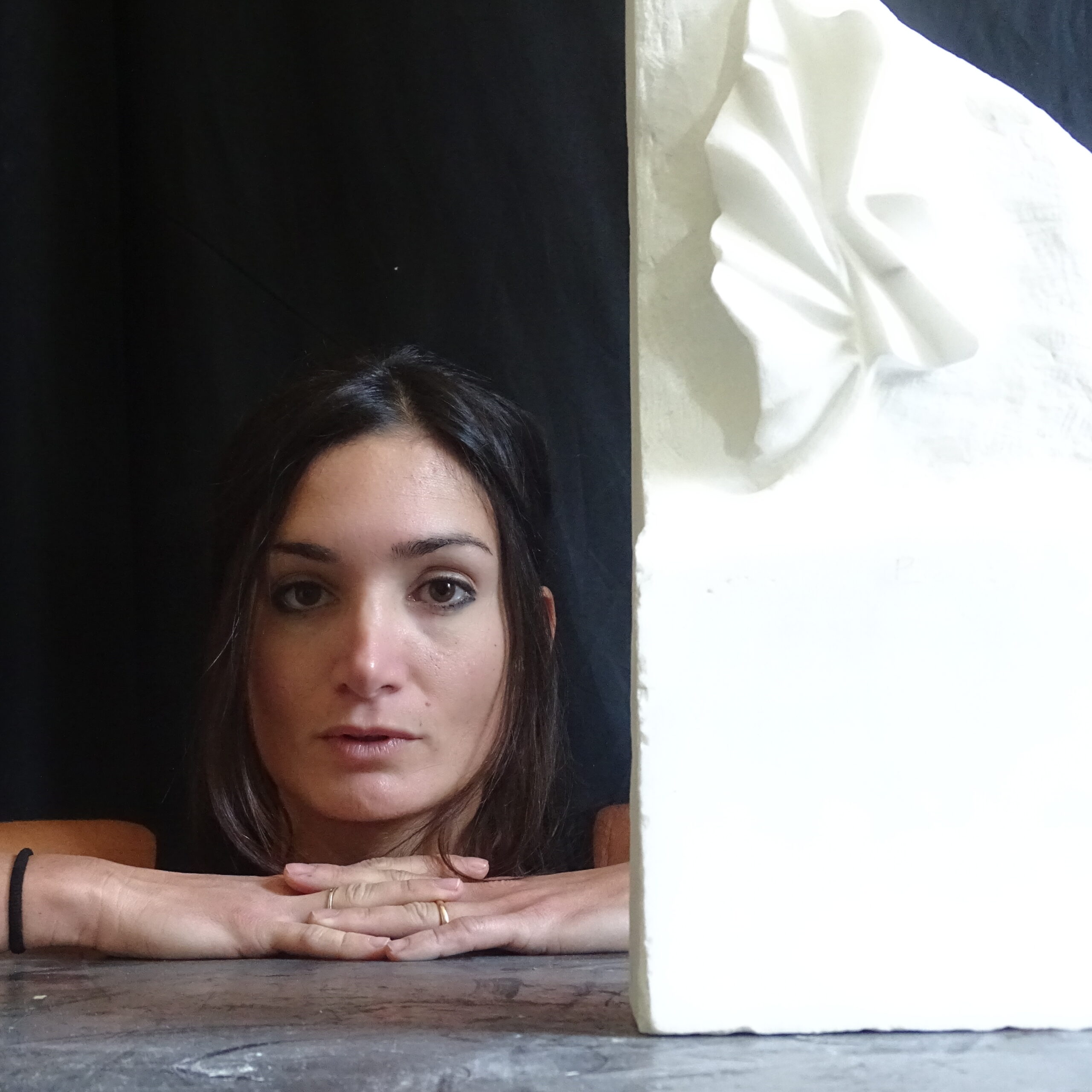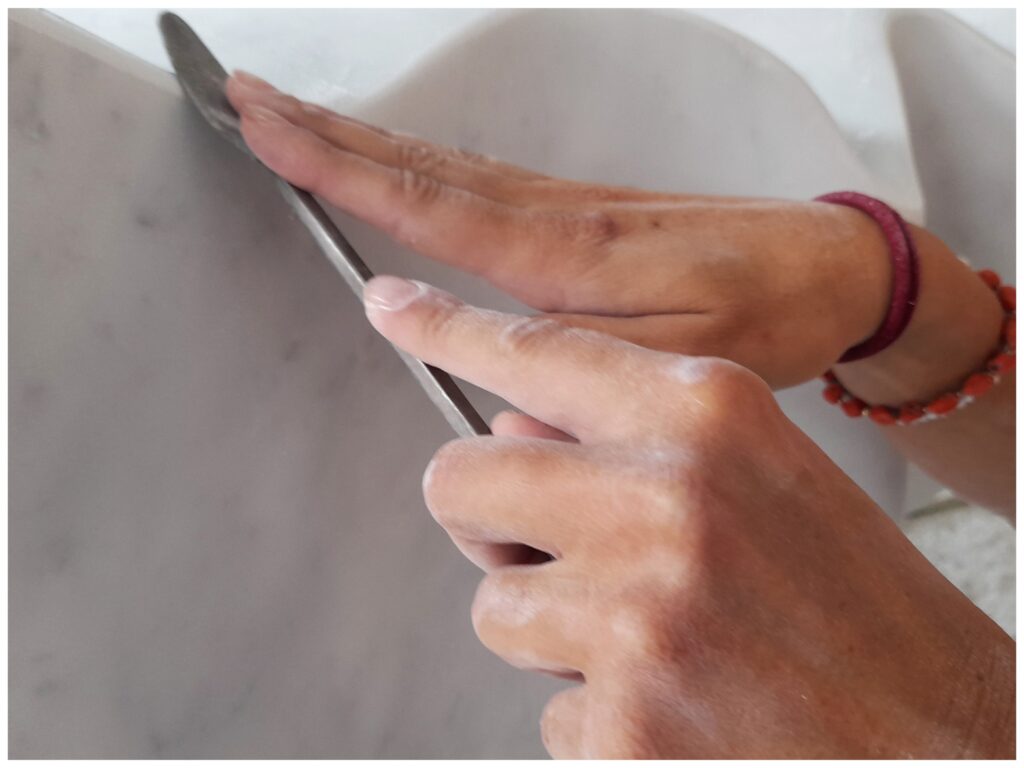I love nature and have chosen to live in a small village surrounded by a green landscape at the foot of the Apuan Alps, where the shadows of the woods meet the whiteness of the marble quarries.
My work is driven by an invincible desire to give lightness to what is heavy, to shape hard stone to make it soft, transparent, and sensual.
My passion is for sculpture that expresses the delicacy and strength of nature as well as emotions, but also the harshness of phenomena; a research that focuses on the study and observation of leaves.
For me, the leaf that transforms the arid earth into a source of life is a metaphor: a leaf that is caducous but regenerates itself; leaves that are all the same and never identical to one another; leaves that together constitute that thin borderline between Earth and Sky.

EVE BEATRICE TAPONECCO AND HER POETRY
A leaf. Eve. In the tree from which she originally comes from: life.
In the plasticity of her form, the primordial seduction, the transgression that makes her figure endlessly fertile.
Dead leaves are gathered together, piled up. The rest of the leaves do not; they continue to dance suspended at every breath of wind, capable of giving each of them a new vocabulary and with it a new meaning that dispenses anthropomorphic forms.
Beatrice’s leaves, sculpted in white marble purity, are this and much more. They are the energy that comes to life from apparently cold material, which becomes the mother of new creatures, daughters of the artist, capable of generating warmth and color for our souls. For the artist, there is no separation between art and life.
There is no separation between the material and the plasmatic movement. There is suffering and joy in the act of creation. Each time it is a detachment that, little by little, is revealed in the stone that the hands shape. It is a part of itself that from the body, naked and unadorned, becomes tangible for our eyes, thanks to a defined and recognizable expression. A talent, mixed with courage, that is able to deprive the material of that part of it that does not turn it into a work, but only into a vehicle or medium of the most profound way of feeling.
That is how it is if one wants, though even more so if one allows the work to appear as the fruit of primordial sin. Exactly like the fruit of Eve. Because sculpting, for the artist, is a challenge with the unknown, with what, free of sketches, her hands will be able to create.
The work is an apple plucked from the tree – the tree of the knowledge of good and evil. Because art is joy, transgression, and if the woman, before she disobeyed to taste the forbidden fruit, was perfect and immortal, it is only thanks to the awareness of her imperfection that she continues the search for the perfection of the forms with which she can represent herself. And of what the mind and body can bring to life.
This is an admirable attempt, perhaps as futile as it is useless, knowing that perfection is inimitable and as such has the value of a fixed point in infinity, which recedes every time one tries to reach it.
The momentum that gives meaning to the work arises from this spasmodic exploration and releases an energy that spreads out, enveloping the observer until it leads him into the same dance that the forms create for our eyes.
The advice for the viewer is to let go, to transcend the materiality of the work in order to grasp the sublimity of art. To try to transcend, to be able to caress the artist’s soul hidden in what she has created, inspired by what is most universal in art, by what leads one to experiment to the point of transcending, to then find oneself in what is most metaphysical thanks to the levelling of material to material.
P. Asti

Biography
After graduating from Art School in Carrara in 2006, she applied to the Faculty of Architecture in Florence. Although she attended the three-year course with excellent results, she realized that this was not her path, so she interrupted her studies and moved to Pulica: a small medieval village at the foot of the Apuan Alps.
Her interests and passion for art led her to resume her studies; she enrolled at the Academy of Fine Arts in Carrara and in 2016 she graduated with a three-year degree in Visual Arts with a thesis on the forest, which has become the subject of her artistic research and which she will approach in the various possibilities of the material in its different forms, moving between sculpture, installation and photography.
She then attended a two-year course in sculpture, and it was here, under the guidance of Professor Pier Giorgio Balocchi, that she discovered her true passion for marble. Professor Balocchi described her as: “An artist of delicate and powerful talent who in recent years has given considerable proof of herself, creating works where youth does not obscure the exquisite and accomplished execution and where creativity is expressed lyrically. Beatrice has recently dedicated herself to marble: and in this material she has composed sculptures of stupendous workmanship, in the most “musical” reality of the “Marble Sculpture” of the School of Carrara.
In 2019, she graduated with the highest scores and honors from the Academy of Fine Arts with a thesis on the work and poetry of Gigi Guadagnucci, whose sensitivity and refined technique are still an inimitable source of inspiration.
While still a student at the Academy, she made her debut with her first solo exhibition at the gallery of Carrara’s cathedral showing an important exhibition on the forest which was organized and presented by Professor Francesco Galluzzi. The exhibition included drawings, marble sculptures, plaster models and installations sponsored by the Italian company “Furrer S.p.A.” with the sponsorship of the Municipality of Carrara and the “UNESCO Carrara dei Marmi club”.

You can enter the woods – you can get lost in them and they can enlighten you. Modern painting was born in the woods (Barbizon forest or Fontainebleau forest) and then moved to the city (Paris). This is the topographical path from mid-19th century French landscape painting en plein air to Impressionism.
The great dream of mankind has been to penetrate the work of art, to be able to slip into the image and experience it, marked by the search for the healing of this wound of anxiety that has produced more or less functional palliatives throughout the history of art – from the fresco decoration of environments, to the synesthesia of Baroque constructions, to the installations of the second half of the 20th century up to virtual reality and 3D cinema. After all, what is art, compared to reality, if not a palliative?
You cannot enter photographs, just as you cannot enter paintings and you cannot talk to statues (those who have succeeded, like Don Juan Tenorio, usually ended up badly…). However, you can walk in the frescoed rooms or inside art installations.
F. Galluzzi
“Can one experience Eden? Or only the loss of it? It is no coincidence that the myth of the forest has always been a myth of loss, but also of illumination. Beatrice has been questioning the forest for a long time with her visual research, as a place of emotional disorder (in all the good and precious senses of the term), but also as a place where one can succeed in finding oneself. An Eden sought after, transformed, and questioned through the possibilities of matter – in its different declinations. An Eden that can be crossed, photographed, artificially reproduced, to measure its surprises and possibilities. The forest is reproduced, staged, and brought directly into the exhibition space – as if to demonstrate that its meanings are multipliable, never reducible. After all, Beatrice is a woman, that is to say, as Franz Wedekind wrote, a soul that in Eden wipes the sleep from its eyes.”
(from the introduction to the exhibition by F. Galluzzi)
The work on marble that is focused on leaves reveals a shared appreciation of the relationship between time and nature. The main feature continues to be the cooperation between cohesive entities that seem to belong to different orders of magnitude, but masquerade to be identical. Art is a part of nature and vice versa. It can capture and pass on positive memories of an inspiration that must not be forgotten. The artist delicately reworks the hardness of the material, searching for its ultimate nature. One after the other, the leaves reveal the whiteness of an ethereal material. It is a form that is returned, the creation recreates the existing, even in the variation of materials. Beatrice preserves the sense of an authentic revelation. Art, we repeat, is not in competition with nature because it becomes a component of it, it acts on memory linked to archetypes, to something we cannot do without, even if the speed of existence today does not allow us to take part in it. The time of sculpture regains life, becomes genesis in these precious and poetic works, as does the wonder of simplicity.
Valerio Dehò


When a leaf sprouts, it is as if nothing happens: one waits, like insects, for the flowers to bloom, for the fruit to ripen.
It is rather when a leaf dies that complicated and worrying thoughts creep into everyone’s thoughts.
A leaf that is born has no history, a leaf that dies is an accomplished experience and has shaped its own destiny.
Exactly like the leaves that Beatrice Taponecco has been sculpting for some time.
What we have here is a large, soft, smooth leaf, free of veins, floating in the air, as if folded in on itself, but without curling up, which is supported in its upward thrust by the impetuous development of a wave, while at the other end it folds its wings, while the movement is completely reabsorbed by a brief suction of the form, which forces the foam to become marble again.
A shape from which emanates an almost impalpable yet persistent luminosity, nourished by the interweaving of a silk-thin warp with a soft and vaporous weft, which does not intend to renounce its consistency, like a powder even when it is forced to incinerate in the most hidden folds, where the darkest shadows are repressed.
The simple silhouette, as always the forms of nature, of the leaf nevertheless remains enclosed in a contour line, fluid and uninterrupted, even at the tips, which round off and curve with rhythm and harmony, in a continuous articulation of open surfaces, which develop almost without edges, as the corners have been smoothed, softened or rounded off altogether.
Hidden in this development is an ancient wisdom, the broad way of the sculptural art, the ability to create, even in hard material, the plastic development of a lightness without rigidity, suited to a form so alive that it does not rest in its skin, smoothed by the wind, consumed by water, calcined by the sun, like a cuttlefish bone.
One thus discovers an almost animal body, in this form that should be a vegetable form. A form in which a sense of stillness is established, but not quite of serenity, as there is still an atmosphere of suspension that one can feel evaporating, as if in eager anticipation.
Perhaps of another ‘blizzard hitting the hard leaves of the magnolia’.
Massimo Bertozzi
The artist works in Carrara, specializing in white statuary marble from the Apuan Alps for her works. She previously created her sculptures at the ‘Sculpture and Design SGF’ sculpture laboratory, which collaborates and has collaborated with artists such as: Max Bill, Jean Dries, Larry Kirkland, Silvio Santini, Maki Nakamura, Julio Silva, Roland Baladi and currently at the ‘Cooperativa Scultori di Carrara’ located in the Polo delle Arti di San Martino, where Aidan Salakhova, Giuseppe Donnaloia and Pier Giorgio Balocchi, among others, perform their works.
The artist has participated in various sculpture symposia, including the prestigious ‘International FVG Stone Sculpture Symposium’ and has exhibited in numerous solo and group exhibitions; she has also won national and international sculpture competitions. Her works can be found in public and private collections.
The critics who have written about Beatrice Taponecco’s work are: Valerio Dehò, Alessandro Chiodo, Francesco Galluzzi, Piergiorgio Balocchi, Massimo Bertozzi, Bruno d’Udine, Angelo Tonelli, Paolo Asti
